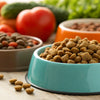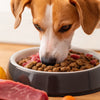Can I Feed My Dog Raw Meat and Kibble? Understanding the Benefits and Guidelines
- Houndsy
Table of Contents
- Introduction
- The Evolution of Dog Diets
- The Benefits of Mixing Raw and Kibble
- Addressing Common Concerns
- Practical Feeding Guidelines
- The Role of Fresh Ingredients
- Monitoring Your Dog’s Health
- Conclusion
Introduction
Have you ever wondered if it’s safe to mix raw meat with kibble in your dog’s diet? You're not alone! Many dog owners grapple with this question, looking for the best way to nourish their furry friends. With an estimated 60% of pet owners considering alternative diets for their dogs, the rise of raw feeding has sparked curiosity and confusion alike. According to recent studies, a significant number of dogs thrive on mixed diets that incorporate both raw and processed foods.
In this blog post, we will delve into the intricacies of feeding your dog a combination of raw meat and kibble. By the end, you will understand the potential benefits, any risks involved, and how to implement a balanced mixed diet. We’ll also explore practical feeding tips and guidelines to ensure your dog gets the nutrients they need while enjoying their meals.
Let’s embark on this journey together to discover the best feeding practices for our beloved pets. Are you ready to rethink your dog’s diet?
The Evolution of Dog Diets
Understanding Canine Nutrition
Dogs have evolved from their wild ancestors into the domesticated companions we love today. This evolution has influenced their nutritional needs. Historically, dogs were scavengers, consuming a variety of foods—meat, vegetables, and grains—found in their environments. Today, many pet owners are revisiting these natural feeding habits by incorporating more fresh, whole foods into their dogs’ diets.
The Rise of Raw Feeding
In recent years, raw feeding has gained popularity among pet owners seeking to replicate a more natural diet for their dogs. Proponents argue that raw meat provides essential nutrients, improves coat health, enhances digestion, and could potentially reduce allergies and sensitivities. However, the idea of mixing raw food with kibble raises several questions and concerns among pet owners.
The Benefits of Mixing Raw and Kibble
Nutritional Balance
One of the primary advantages of mixing raw meat with kibble is the potential for a well-rounded diet. Kibble often contains carbohydrates and fiber, while raw meat provides protein and essential fatty acids. By combining the two, you can offer your dog a more diverse array of nutrients, which can contribute to their overall health and vitality.
Cost-Effectiveness
Feeding exclusively raw can be expensive, especially for larger breeds. Mixing raw meat with kibble allows pet owners to stretch their budgets while still providing some of the health benefits associated with raw feeding. For many families, this hybrid approach can make it more feasible to provide high-quality nutrition without breaking the bank.
Improved Digestion
Many dogs can adapt well to a mixed diet. A gradual introduction of raw food can help dogs maintain a healthy digestive system, as their gut microbiome can adjust to the different types of nutrients they receive. It’s essential, however, to monitor your dog’s reaction to the mixed diet and make adjustments as needed.
Addressing Common Concerns
Will Mixing Raw and Kibble Cause Digestive Issues?
One of the most common myths is that feeding raw and kibble together can lead to digestive problems, such as upset stomachs or worse. In reality, dogs have evolved digestive systems capable of processing a variety of foods. The key to successful mixed feeding lies in the gradual transition and observing your dog’s individual reactions.
The Importance of Transitioning
To avoid digestive upset, it’s crucial to introduce raw food slowly into your dog’s diet. Start by mixing small amounts of raw meat into their kibble, then gradually increase the proportion over a period of several days. This allows your dog’s digestive system to adjust and minimizes the risk of gastrointestinal disturbances.
Practical Feeding Guidelines
How Much Raw and Kibble to Feed?
The ratio of raw meat to kibble can vary based on your dog’s size, age, activity level, and health conditions. A common guideline is to start with a 50/50 mix and adjust based on your dog’s needs. Consulting with your veterinarian can help you determine the ideal ratio for your furry friend.
Meal Timing
Some dog owners prefer to feed raw and kibble at different times of the day. For example, kibble can be served in the morning for convenience, while raw food can be provided in the evening when there is more time to prepare. This method ensures that your dog’s digestive system can handle the different food types without mixing them in the same meal.
Choosing Quality Ingredients
When mixing raw and kibble, it’s essential to choose high-quality ingredients. Opt for kibble that contains real meat as the first ingredient and minimal fillers. For raw meat, select reputable sources to ensure the meat is fresh and safe for your dog. Avoid meats that are harmful or contain additives, such as onions or garlic.
The Role of Fresh Ingredients
Incorporating Vegetables and Supplements
Adding vegetables to your dog’s diet can provide additional fiber and nutrients. Consider mixing in cooked or raw vegetables like carrots, sweet potatoes, or green beans. Furthermore, you can enhance their diet with supplements like fish oil or probiotics to support overall health.
Hydration Matters
Don’t forget the importance of hydration! While kibble can be low in moisture, raw food often contains higher water content. Ensure your dog has access to fresh water at all times, particularly if they primarily consume kibble.
Monitoring Your Dog’s Health
Signs to Watch For
After introducing a mixed diet, keep an eye on your dog’s health. Look for signs of digestive upset, such as vomiting, diarrhea, or changes in appetite. If any concerning symptoms arise, consult your veterinarian for guidance.
Regular Vet Check-Ups
Regular veterinary check-ups are crucial to monitor your dog’s health and dietary needs. Your vet can provide tailored recommendations based on your dog’s specific requirements, ensuring they receive optimal nutrition.
Conclusion
Feeding your dog a mixture of raw meat and kibble can be a beneficial approach to their nutrition, provided it’s done thoughtfully and gradually. The key is to find a balance that suits your dog’s individual needs while ensuring they receive a variety of nutrients. As loving pet owners, we strive to give our dogs the best, and a mixed diet can be a step toward achieving that goal.
Are you ready to elevate your dog’s feeding experience? Explore our Houndsy Kibble Dispenser, designed to simplify mealtime while maintaining the beauty of your home decor. Order now here and make feeding time a delightful ritual for both you and your furry friend!
FAQ
Can I feed my dog both raw meat and kibble?
Yes, most dogs can safely consume a mixture of raw meat and kibble as long as the transition is gradual and monitored.
How much raw meat should I mix with kibble?
A common starting point is a 50/50 mix, but the ratio can vary based on your dog's size, age, and health needs.
Will mixing raw and kibble cause digestive issues?
Generally, mixing raw and kibble does not cause digestive problems if introduced gradually. It's sudden dietary changes that can lead to issues.
How do I transition my dog to a mixed diet?
Begin by slowly integrating small amounts of raw meat with their kibble, gradually increasing the raw portion over several days.
What should I do if my dog shows signs of digestive upset?
If your dog experiences vomiting, diarrhea, or a loss of appetite, consult your veterinarian for advice on adjusting their diet.













